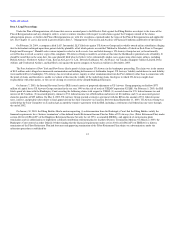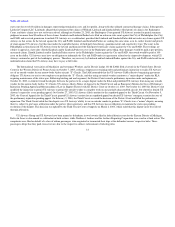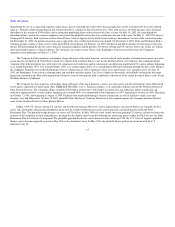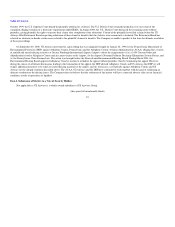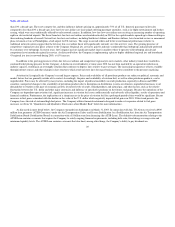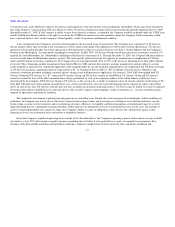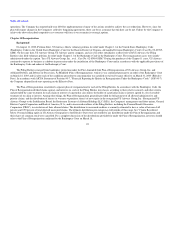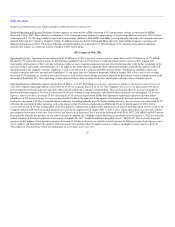US Airways 2003 Annual Report Download - page 26
Download and view the complete annual report
Please find page 26 of the 2003 US Airways annual report below. You can navigate through the pages in the report by either clicking on the pages listed below, or by using the keyword search tool below to find specific information within the annual report.
Table of Contents
its common stock, make additional corporate investments and acquisitions, enter into mergers and consolidations and modify certain concessions obtained as
part of the Chapter 11 reorganization. Effective March 12, 2004, US Airways obtained covenant relief for the measurement periods beginning June 30, 2004
through December 31, 2005. If the Company is unable to meet these financial covenants, as amended, the Company would be in default under the ATSB Loan
and the Stabilization Board would have the right to accelerate the ATSB Loan and exercise other remedies against the Company. Such acceleration would
have a material adverse effect on the Company's future liquidity, results of operations and financial condition.
A key component to the Company's overall restructuring plan is the increased usage of regional jets. The Company uses regional jets to fly into low-
density markets where large-jet flying is not economical as well as replace turbo props with regional jets to better meet customer preferences. US Airways'
agreement with its pilots provides that it may operate up to 465 regional jets, subject to certain restrictions (see Item 1 "Airline Industry and the Company's
Position in the Marketplace" for more details regarding the restrictions). In May 2003, US Airways Group entered into agreements to purchase a total of 170
regional jets from Bombardier, Inc. (Bombardier) and Empresa Brasileira de Aeronautica S.A. Through December 31, 2003, the Company had taken delivery
of seven aircraft under the Bombardier purchase contract. The order equally splits between the two regional jet manufacturers a combination of 170 firm
orders and 380 options to purchase regional jets. The Company has secured approximately 85% to 90% of the necessary financing for its firm-order regional
jet aircraft. These financings include commitments from General Electric (GE) and from the respective airframe manufacturers and are subject to certain
credit standards or financial tests. Among the applicable credit standards under the aircraft financing commitments is the requirement that US Airways Group
or US Airways maintains a minimum corporate credit rating of "B-" by Standard & Poor's (S&P) or "B3" by Moody's Investor Service (Moody's) and
customary conditions precedent including a material adverse change clause with prospective application. On January 9, 2004, S&P downgraded both US
Airways Group and US Airways to a "B-" rating and US Airways Group and US Airways remain on CreditWatch. US Airways Group and US Airways
cannot be certain that they will be able to maintain these ratings, particularly in view of the ongoing weakness in the airline industry and the net losses
experienced by the Company. If US Airways Group or US Airways, as the case may be, is unable to maintain at least its current corporate credit rating of "B-"
from S&P, GE and/or any of the airframe manufacturers may, at their sole discretion, elect not to provide financing for the regional jet orders as described
above. In such event, since US Airways currently does not have available any alternative financing sources, US Airways may be unable to execute its regional
jet business plan which would likely have a material adverse effect on the Company's future liquidity, results of operations (i.e., revenue contribution from
regional jet operations) and financial condition.
The competitive environment is putting increasing pressure on controlling costs. Despite the recent emergence from bankruptcy and the resulting cost
reductions, the Company may not be able to effectively counteract decreasing revenues and increasing costs through its cost reduction initiatives, revised
business plan, customer service initiatives and revised pricing structures. Moreover, its liquidity and borrowing options are limited and it may be severely
impacted should there be a prolonged economic downturn, further decreases in demand for air travel or substantial increases in fuel costs. The inability to
achieve sustained profitability may negatively impact the Company's ability to satisfy its obligations as they become due, obtain future equity or debt
financing or to do so on economical terms and sustain or expand the business.
Given the Company's significant operating losses and the factors described above, the Company is pursuing a plan to further reduce cost per available
seat mile by at least 25% built around a complete business remodeling that will allow it to be profitable in a variety of competitive environments. Key
elements of this plan include marketing and distribution techniques, employee compensation, benefits and work rules, and airline scheduling and
21



